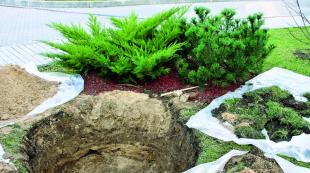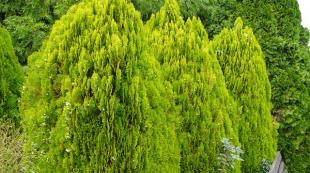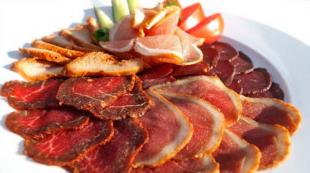Description of the barberry plant, use in folk medicine. Barberry ordinary
Name in the languages of the peoples of the Caucasus - Akatsakhur(Abkhazian). Tzor (Armenian)
Description
Barberry (the Latin name "ber-beri" means "bear berry") is a slightly prickly branched shrub up to 1.5-2 m high.
Barberry ordinary, sour
One of characteristic features common barberry - yellow its wood.
He has a powerful root and woody creeping rhizomes.
shoots elongated, bearing 3-5-segmented spines, and shortened, with green thin leaves. The bark is greyish.
Leaves small, elliptical or fraternal, blunt towards the apex, with serrated edges, growing from the base of the spines.
flowers bisexual, in drooping racemes, consisting of 6, rarely 9 yellow sepals, 6 yellow petals, 6 stamens, ovary superior unilocular.
They have a peculiar smell. Blossoms in May - June, fruits ripen in August.
Fetus- 2-3 - oblong seed berry, bright red, oval, up to 1 cm long, with brown seeds, sour taste, unripe poisonous. Ripens in August - September. On the Black Sea coast in June
Spreading
In the wild, it is found in the Baltic states and the European part of our country to the Crimea and the Caucasus
habitats
Grows on open, slightly soddy stony slopes, rocks and talus, occurs under the forest canopy, along river valleys, forest edges,
Common barberry Growing conditions
The common barberry is undemanding to soil and moisture, does not tolerate waterlogging. This is a photophilous plant. Frost-resistant.
Barberry ordinary Reproduction
Barberry propagates by seeds and vegetatively, with the help of root offspring. Seeds are sown in autumn before frosts in beds well fertilized with manure. The distance between the rows is 15-20 cm. The soil is lightly rolled after sowing. Seeds germinate in April - May. In autumn, seedlings are planted in a permanent place.
Reproduction of barberry by root offspring is carried out in the fall after the complete fall of the leaves. Well developed: root suckers are dug in and removed with a part of the rhizome located in the surface layer of the soil. After growing the seedling in the nursery for a year, it is planted in a permanent place in a hole 25-30 cm deep with the addition of manure. The soil around the seedling is compacted and watered. Plant care consists in regular loosening, weeding and watering. Barberry is a cross-pollinated plant. In the absence of bees, bumblebees and other insects, fruits may not set, therefore, pesticides should not be used during the flowering of plants and plants with a pungent odor that repel beneficial insects should not be grown on the site.
Chemical composition
All organs of the plant contain alkaloids. The main alkaloid isolated from the roots of the common barberry is berberine. In addition to berberine, the roots of the plant contain palmatin, leontin, columbamine, iatroricin, berberrubin, and oxyacanthin. In addition, tannins essential oil, carotene and vitamins C and E.
Barberry fruits contain malic, citric, bath and other organic acids, sugars, pectin substances, ascorbic acid and carotenoids. Contain up to 5% sugars and 6-7% malic acid. They make jam, lemonades, drinks, sweets, seasonings.
In the leaves of 12% ascorbic acid and about 40% vitamin E, there are alkaloids, in particular berberine.
Medicinal raw materials
Medicinal raw materials are leaves, roots and berries. The leaves are harvested in the phase of budding and flowering of the plant, discarding diseased and damaged by pests. Dry in the shade or under a canopy. The raw material has a peculiar smell, the taste is sour. Store in bags in a ventilated area for 3 years. The roots are harvested in spring or autumn, cutting down or ditching the bush. root system should not be fully used, it is necessary to leave a root cutting 10-15 cm long. For every 10 m2 of barberry thickets, it is supposed to keep one intact bush.
The harvested raw material is cut into pieces 10-20 cm long, thoroughly shaken off the soil and rotten and blackened parts are removed. The bark flakes off very easily, so a tarp or other material must be placed under the bark so that the raw material is not lost. The berberine contained in the raw material is highly soluble in water, for this reason the roots are not washed, but dried in a ventilated room or in a dryer at a temperature of 45 ... 50 ° C, periodically turning over. Stored in bags, protecting from moisture, 3 years.
Application
Decorative, Medicinal, Honey plants, Food-Fruit, Technical.
Application in medicine
Therapeutic action- antiseptic, appetite stimulant, hemostatic, diuretic, antipyretic, choleretic, normalizing metabolism, diaphoretic, sedative, laxative, tonic and restorative, toxic.
Indications for medical use- diseases of the digestive system, diseases of the kidneys and urinary tract, diseases of cardio-vascular system, diseases of the blood and hematopoietic organs, diseases of the respiratory system, diseases nervous system, diseases of the reproductive system, diseases endocrine system, diseases of the immune system, diseases of the oral cavity, metabolic diseases, infections and invasions, hypovitaminosis, symptoms and syndromes, neoplasms.
Toxicity- antibacterial, insecticidal
As a medicinal plant, barberry has been known since ancient times. During excavations in Egypt, clay tablets were found on which it is written that barberry berries are used to "purify the blood." Even earlier, this berry, as a medicinal one, was used in India. Currently, Berberine is obtained from the roots of barberry, recommended in the treatment of diseases of the liver and gallbladder, as a hemostatic agent.
Dry leaves, roots and bark are used for jaundice, as an antipyretic and antimicrobial agent, as well as for rinsing the mouth with inflammation of the gums. Barberry berries quench thirst, stimulate appetite and have laxative properties. Juices, drinks, jam, seasoning for meat dishes are made from berries. Unripe berries are poisonous, they can be consumed after ripening. Young leaves are used for salad.
Barberry preparations are used for chronic diseases of the liver and gallbladder, peptic ulcer of the stomach and duodenum, inflammation of the upper respiratory tract, tuberculosis and uterine bleeding in the postpartum period. They are used in the complex treatment of tumor diseases and morphinism.
The common barberry is an integral part of the fees used to treat the liver. Root decoction, infusion and tincture of leaves are used internally and externally in the form of lotions and rinses.
The tincture is prepared with 40% alcohol or vodka. For this, 20 g of leaves are poured into 100 ml of alcohol, insisted in a warm place for 10-15 days until a transparent dark yellow liquid of a slightly sour taste forms. Take 30-40 drops 2-3 times a day. The course of treatment is 2-3 weeks.
To prepare the infusion, 1 tablespoon of crushed dry leaves is poured into 1 cup hot water, boil in a closed enamel bowl in a water bath for 5-10 minutes, filter through two or three layers of gauze, wring out and bring the volume boiled water to the original. Take 1 tablespoon 3-4 times a day before meals or use for rinsing and lotions.
Recipes for various diseases
Arthritis
Pour 20 g of barberry fruit with 0.5 l of boiling water, leave for a day. Drink during the day.
Hepatitis
Grind 1 tablespoon of barberry leaves, pour 1/2 cup of 70% alcohol, leave for 2 weeks in a dark place at room temperature. Strain, take 30 drops 3 times a day.
Diabetes
THIRST IN DIABETES
Grind barberry flowers, pour 1 teaspoon of 1 cup of boiling water, boil over low heat for 10 minutes. Strain, take 1 tablespoon 3 times a day.
Grind dry fruits of barberry, pour boiling water over them in a ratio of 1:10. Insist 2 hours in a thermos. Strain, take 1/2 cup 3 times a day.
Uterine bleeding, Diarrhea
Pour 1 teaspoon of crushed bark or barberry roots into 2 cups cold water, insist 4 hours, strain. Take 1/2 cup 4 times a day.
According to medieval pharmacology
Urticaria, conjunctivitis, liver tumors
Tzor is the Armenian name for the common barberry,
It is also called parparie 1 or amirparis 2, i.e. zrishk 3. There is black and red.
best view is red and fresh. His nature is cold and dry in the second degree. Has strengthening properties. Its juice eliminates hops and intoxication. And the bark of its root strengthens the teeth and cures a cancerous ulcer. Helps with rashes in the mouth. Strengthens hair roots. Sharpens vision. Helps with inflammation of the eyelids. Strengthens the heart and helps with hot palpitations. Stops the secretion of yellow bile. Strengthens the liver and stomach, quenches thirst and stops belching. Strengthens nature and causes appetite. If you drink [a decoction] of the bark of its root, it will strengthen the liver. Helps with intestinal ulcers and old diarrhea. And if lubricated, it will help with a hot tumor. Its syrup moderates the sharpness of the blood. And the flowers cleanse [the skin of] traces of scars. They help with lichen, which is formed from [excess] yellow bile. It also helps with hives. Its dose at the reception is 12 drams. But it is harmful in black bile diseases. Its harmful action eliminates rose jam. And the substitute is sumac.
Paten says that the Persians call him zrishk, the Arabs - amirparis, and the Turks - garaguh 4 or khatup tuzlukhi 5 . The best kind is ripe, fresh, oily, red with a blackish tinge. His nature is cold and dry in the second degree. Dissolves yellow bile
1. Greco-Latin term Berberis of Eastern origin (from Berberi letters, "shell").
2 "Amirbaris" (Arabic) - common barberry, Berberis vulgaris L., in medieval Eastern botany, often confused with the name of the prickly hawthorn
3 "Zirishk" (Persian) is used in Armenian botanical terminology along with "Dor" (Armenian).
4. "Karamuk" (tour.).
5. Kadin tuzlugu (tur.) - barberry, Berberis vulgaris L. (Berberidaceae)
Use in design
Barberry ordinary refers to ornamental plants. In autumn, its bushes are covered with bright red fruits that persist throughout the winter. Barberry is valued not only for the bright color of the fruit, but also for the colorful foliage. It withstands shearing and unusual formation of bushes. Can be used to create hedges. Usually it is planted along the fence or on the border of the site.
Blooms in IV-V; bears fruit in IX-X.
In the north and in central Russia, it is included in the main assortment of shrubs in gardens and parks. It is mainly used to create living clipped hedges. It should not be planted near fields, as it is an intermediate host of the rust fungus Puccinia graminis Pers., which infects cereals.
food application
drinks, salad and vegetables.
Ripe berries are edible, they are widely used as a seasoning for meat dishes, for making drinks, compotes and jellies, dried, pickled and salted, harvested for the needs of the food industry.
Technical application
In the national economy, lemon yellow wood is used as an ornamental material. The bark is used to dye wool and skin yellow and yellow-red. The juice of ripe berries with the addition of alum gives woolen, linen and cotton fabrics a pink tint.
Forms
- f. atropurpurea Rgl. (var. purpurea Bert.) - with dark red-violet sepals. The most common form. In Russia from Kirovsk to Crimea in the southern Primorye of the Far East, Kazakhstan, Alma-Ata, Western Ukraine and the Baltic states.
- f. marginata Rgl. - leaves with a white border around the edge.
- f. aureo-marginata Rgl. - Leaves are golden red. A form rarely seen; in Ukraine - in Sofievsky park in Uman in Ukraine.
- f. macrophylla hort. - the leaves are large.
- f. macrocarpa hort. - the fruits are larger, rounded.
- f, rotundifolia hort. - the leaves are rounded.
- f. serrata C. K. Schneid. - deeply toothed leaves.
- f. arboreahort. (f. Knightii hort.) - a trunk branching in the upper part.
- f. lutea Rgl. - fruits are bright yellow.
- f. Alba West. (var. leiocarpa Ktze.) - fruits are white or yellow.
- f. enuclea West. (var. asperma West.) - fruits without seeds.
- f. dulcis Loud. (var. edulis L.) - fruits are slightly sour, sweetish.
- f. sulcata C. Koch - pb strongly ribbed.
Almost all forms are available in the park of the Agricultural Academy. Timiryazev in Moscow (Schroeder).
hybrids
- B. Neubertii Baumann (B. vulgaris x Mahonia aquifolium), listed in Moscow (Schroeder) and Kaliningrad.
- B. laxiflora Schred. (B. vulgaris x B. amurensis), listed in Sukhumi and Sochi.
- B. macracantha Schred. (B. aristata x B. vulgaris), winter-hardy enough in Leningrad.
- B. serrata Koehne (B. vulgaris x B. sibirica), characterized by sufficient winter hardiness and drought resistance; known in Kaliningrad, in the Oryol region. at the Forest-Steppe experimental station, where it is winter-hardy (Vekhov), in Dnepropetrovsk, where it bears fruit (Rudy), in Kyiv, in Leningrad - it freezes a little.
Shrub with 3-5 separate spines at the base of the leaves. It has many medicinal properties (choleretic, diuretic, laxative, hemostatic, etc.). Known as an ornamental plant.
Ask the experts
flower formula
The formula of the common barberry flower is: *Ch3+3L3+3T∞P1.In medicine
In scientific medicine, barberry roots and leaves are mainly used. Tinctures from the leaves and roots of common barberry are widely used in gynecological practice, in particular for hypotension of the uterus in the postpartum period, bleeding during menopause, in combination with other medications - for postpartum endometritis and subinvolution of the uterus. The drug "Berberine bisulfate", obtained from the roots of barberry, is used as a choleretic agent for chronic hepatitis, cholelithiasis. A tincture of barberry leaves also has a moderate choleretic effect; in diseases of the gallbladder (chronic recurrent cholecystitis, gallbladder dyskinesia), its use leads to an improvement in the outflow of bile, a decrease in pain and inflammation. In Russia, common barberry berries are used as a choleretic, diuretic, laxative. Barberry is also used for peptic ulcer of the stomach and duodenum, inflammation of the upper respiratory tract, tuberculosis. It cures diarrhea, dysentery, asthma.
In dermatology
A tincture of barberry leaves is used for eczema and neurodermatitis complicated by liver diseases and digestive tract. Also, a tincture of barberry roots or a decoction of its bark is used for phytodermatitis. Barberry is included in the fees used in the treatment of allergic skin diseases. Berberine, found in barberry, is effective in the treatment of leishmaniasis, including "Pendia's ulcer".
On the farm
For economic purposes, they use solid yellow barberry wood for making souvenirs and small crafts. From ripe fruits with alum, a dye is prepared for paper, flax, wool; from the roots - a yellow dye for skins and wool.
Classification
Common barberry (lat. Berberis vulgaris) is a species of the genus Barberry (lat. Berberis) of the Barberry family (lat. Berberidaceae). The genus unites about 580 species.
Botanical description
Common barberry is a strongly branched, prickly shrub, 1.5 - 2.5 m high, with horizontal woody rhizomes, from which a rather large main root with lateral branches departs. Shoots numerous, erect, yellowish or yellowish-purple, later whitish-gray. Buds up to 1 mm long, sharp, glabrous, surrounded by dilated remaining leaf sheaths. On shortened shoots, normal leaves develop, on elongated shoots instead of leaves - spines, including 3-5, usually 3, less often 5 separate, 1-2 cm long. Leaves are alternate, obversely ovate or elliptical, up to 4 cm long, 2 wide. cm, wedge-shaped narrowed towards the base, with a rounded, less often somewhat pointed apex, finely and sharply dentate-serrate, on short petioles. Racemes 15 - 25 flowered, up to 6 cm long. Flowers are yellow, 6 - 9 mm in diameter, in axillary drooping racemes. The brush consists of 15 - 25 flowers. Each flower has six back-ovate sepals and petals. At the base of the flower are bright orange nectaries. One pistil, many stamens. The formula of the common barberry flower is: *Ch3+3L3+3T∞P1. The fruit is a berry, oblong - elliptical, bright red or purple, up to 12 mm long, has a sour taste. Seeds 4-5 mm long, somewhat flattened and narrowed at the top. Blooms in April - May. The fruits are edible, ripen in September - October.
Spreading
It grows in the south of the European part of Russia, mainly in the Caucasus. It settles on the slopes of ravines, in river valleys, on rocky lands and forest edges. In many areas of southern and middle lane European Russia is widely bred as an ornamental and fruit plant.
Distribution regions on the map of Russia.
Procurement of raw materials
For therapeutic purposes, barberry leaves, roots, bark and fruits are used. Barberry leaves are harvested in May - June, during the flowering period. They are cut with scissors, protecting the hands from thorns. The raw materials are dried, laying out in a thin layer on fabric or paper under a canopy, in attics with an iron roof. Dried leaves are dark green above, light green below, thin, brittle, twisted, peculiar smell, slightly acidic taste. Store in dry, well-ventilated areas, on shelves. Shelf life is usually 1-1.5 years. The roots are harvested in autumn, in October - November, or in spring, in April. Dig up, shake off the ground, cut off small roots, dry in the air (do not wash, since the berberine contained in them dissolves well in water), then cut into pieces up to 2 cm. Dry under a canopy, in attics, in a dryer or oven at a temperature 45-50°C for 4-5 days. Dried roots are longitudinally wrinkled, lemon-yellow inside, brownish outside, weak smell, bitter taste.
It is not recommended to use the root system completely, it is necessary to leave a root cutting 10-15 cm long. For every 10 m 2 of the barberry thicket area, it is supposed to keep one intact bush. At roots with a diameter of more than 6 cm, only bark with a small amount of core is used. Pack them in bags. Shelf life 3 years. The bark is harvested in April - May from young branches during sap flow. The branches are cut annularly at a distance of 10-15 cm, longitudinal cuts are made and the bark is removed. Dry as well as the roots. The dried raw material has the form of tubes or grooves, on the inner surface with small wood residues. The color of the bark inside is yellowish-gray, outside - gray or brownish-yellow. The smell is weak, specific, the taste is bitter. Shelf life 3 years. The fruits are harvested ripe, in late autumn after the first frost. Dry in the sun, attics, under a canopy, in ovens, warm ovens.
Chemical composition
The weight of a part of the common barberry contains alkaloids (up to 0.3%). The alkaloids berberine, berbamine, berberrubine, palmitin, iatrocin, etc. were found in the leaves and roots. In the bark of the roots of the common barberry, in addition to berberine, the alkaloid oxyacanthin, leontine, and also palmitin were also found; in the bark of branches, in addition to alkaloids, there are tannins, dyes and resinous substances. Tannins and resinous substances, essential oil, vitamins C, E, as well as malic and ascorbic acids, carotene, phylloquinone, tocopherols were found in the leaves. Barberry fruits contain sugars, carotene, vitamins K, C (up to 172 mg /%), citric, malic, tartaric acids, berberine, tannins, pectin, dyes, mineral salts.
Pharmacological properties
The action of barberry is mainly associated with the presence of the alkaloid berberine in them, which has antispasmodic and analgesic properties, as well as antibacterial activity. Barberry preparations have anti-inflammatory, choleretic, diuretic, antimicrobial, astringent, hemostatic and antiseptic effects. The mechanism of action of barberry preparations is associated both with an antispastic effect on gallbladder, and with choleretic effect. Relaxation of the gallbladder causes a suction action, drainage of the bile ducts and the cessation of painful pain. Berberine lowers blood pressure, slows down the pulse (with tachycardia), enhances the separation of bile. A tincture of barberry leaves and bark accelerates blood clotting, constricts the vessels of the uterus and enhances its contraction, helping to stop bleeding.
Application in traditional medicine
Barberry was known in ancient times, it was known in Ancient Babylon and India. In the library of the Assyrian king Ashurbanipal, in the inscriptions on clay tablets made in 650 BC, barberry berries are mentioned as a “blood purifier”. In the Middle Ages, the fruits and roots of barberry were widely used in various diseases: jaundice, scurvy, etc.
Tincture of barberry leaves folk medicine It is used in obstetric and gynecological practice for various bleeding, as well as a choleretic agent for hepatitis, hepatocholecystitis, cholelithiasis, gallbladder dyskinesia, exacerbations of chronic cholecystitis without fever, cholelithiasis not complicated by jaundice. An infusion of barberry bark is used for hepatitis, cholecystitis, inflammatory diseases of the kidneys, bladder. An infusion of barberry leaves is used as an anti-inflammatory and choleretic agent for diseases of the liver and gallbladder. A decoction of the roots and bark of barberry is used for cholelithiasis, fever, postpartum uterine bleeding as a hemostatic and anti-inflammatory agent, it can also be used to wash bleeding wounds, ulcers, inflamed mucous membranes of the eyes. A decoction of barberry flowers is taken for pain in the heart, hypertension, hepatocholocystitis, and fever. An infusion of fruits is taken to improve appetite, with gastritis with low acidity of gastric juice, to quench thirst in febrile patients, as an anti-sclerotic agent and to strengthen the capillaries of blood vessels.
Literature
1. Atlas of medicinal plants of the USSR / Ch. ed. N. V. Tsitsin. - M.: Medgiz, 1962. - 702 p.
2. Blinova K. F. et al. Botanical-pharmacognostic dictionary: Ref. allowance / Ed. K. F. Blinova, G. P. Yakovlev. - M.: Higher. school, 1990. - S. 187. - ISBN 5-06-000085-0.
3. State Pharmacopoeia of the USSR. Eleventh edition. Issue 1 (1987), issue 2 (1990).
4. State Register of Medicines. Moscow 2004.
5. Ilyina T.A. Medicinal Plants of Russia (Illustrated Encyclopedia). - M., "EKSMO" 2006.
6. Zamyatina N.G. Medicinal plants. Encyclopedia of the nature of Russia. M. 1998.
7. Medicinal plants: Help Guide. / N.I. Grinkevich, I.A. Balandina, V.A. Ermakova and others; Ed. N.I. Grinkevich - M .: Higher School, 1991. - 398 p.
8. Medicinal plants of the State Pharmacopoeia. Pharmacognosy. (Edited by I.A. Samylina, V.A. Severtsev). - M., "AMNI", 1999.
9. Medicinal plant materials. Pharmacognosy: Proc. allowance / Ed. G.P. Yakovlev and K.F. Pancake. - St. Petersburg: Spec. Lit, 2004. - 765 p.
10. Lesiovskaya E.E., Pastushenkov L.V. "Pharmacotherapy with the basics of herbal medicine." Tutorial. – M.: GEOTAR-MED, 2003.
11. Maznev V.I. Encyclopedia of Medicinal Plants -. M .: Martin. 2004. - 496 p.
12. Mannfried Palov. "Encyclopedia of Medicinal Plants". Ed. cand. biol. Sciences I.A. Gubanov. Moscow, Mir, 1998.
13. Mashkovsky M.D. "Medications". In 2 volumes - M., New Wave Publishing House LLC, 2000.
14. Novikov V. S., Gubanov I. A. Genus Spruce (Picea) // Popular atlas-determinant. Wild plants. - 5th ed., stereotype. - M.: Bustard, 2008. - S. 65-66. - 415 p. - (Popular atlas-identifier). - 5000 copies. - ISBN 978-5-358-05146-1. - UDC 58(084.4)
15. Nosov A.M. Medicinal plants in official and traditional medicine. M.: Eksmo Publishing House, 2005. - 800 p.
16. Peshkova G. I., Shreter A. I. Plants in home cosmetics and dermatology. - M .: Ed. House of SMEs, 2001. - 688 p.
17. Plants for us. Reference manual / Ed. G.P. Yakovleva, K.F. Pancake. - Publishing house " study book", 1996. - 654 p.
18. plant resources Russia: Wild flowering plants, their component composition and biological activity. Edited by A.L. Budantsev. T.5. M.: Association of scientific publications KMK, 2013. - 312 p.
19. Sokolov S. Ya. Medicinal plants. - Alma-Ata: Medicine, 1991. - S. 118. - ISBN 5-615-00780-X.
20. Sokolov S.Ya., Zamotaev I.P. Handbook of medicinal plants (phytotherapy). – M.: VITA, 1993.
21. Turova A.D. "Medicinal plants of the USSR and their application". Moscow. "The medicine". 1974.
22. "Phytotherapy with the basics of clinical pharmacology", ed. V.G. Kukes. – M.: Medicine, 1999.
23. Chikov P.S. "Medicinal plants" M.: Medicine, 2002.
In the article we discuss barberry - beneficial features and contraindications for use. You will learn what the plant looks like and what varieties it has. We will talk about the medicinal properties of barberry and its use in diseases of the heart, stomach, liver and immunodeficiency.
Barberry is a genus of evergreen shrubs or trees of the Barberry family (lat. Berberidaceae). The plant has thin, branched shoots covered with brown ribbed bark. The leaves of the barberry are collected in bunches, grow on short petioles. The fruits are elongated or spherical berries of red or black color, depending on the variety.
Spring view (photo) of barberry
Barberry is a frost-resistant and heat-resistant plant. It is unpretentious to growing conditions, but does not tolerate waterlogged soil.
The plant is found throughout Europe North America, Persia, Central Asia and Kazakhstan. In our country, barberry grows in the Crimea, Siberia and the Caucasus.
Dye is obtained from the wood and roots of the plant. Leaves and berries of barberry are used in cooking and folk medicine. We will talk about the beneficial properties and contraindications of barberry berries below. Read more about the use in cooking in the article - Dishes from barberry.
Types of barberry
The genus Barberry (lat. Berberis) combines 580 plant species. The most common of them:
- common barberry (lat. Berberis vulgaris);
- Canadian barberry (lat. Berberis canadensis);
- hawthorn barberry (lat. Berberis crataegina);
- imitating barberry (lat. Berberis aemulans);
- Siberian barberry (lat. Berberis sibirica);
- barberry oblong (lat. Berberis oblonga);
- barberry Thunberg (lat. Berberis thunbergii);
- Amur barberry (lat. Berberis amurensis);
- warty barberry (lat. Berberis verruculosa).
Amur and common barberry have edible fruit. It is these two types of plants that are used in cooking and traditional medicine. We will tell you in more detail how barberry is useful and how to use it to strengthen immunity and in diseases of the heart, liver, and stomach.
Useful properties of barberry
Barberry is widely used in folk and traditional medicine.. In pharmacies, you can find plant-based medicines: Cholelitin, Berberine biosulfate and barberry tincture.
For the production of plant-based products at home, berries, leaves, bark and roots are used. Barberry is cultivated on household plots. The medicinal properties of the garden barberry do not differ from the properties of the wild-growing barberry. Therefore, any plant can be used to prepare medicines.
The benefits of red barberry are chemical composition. The plant contains alkaloids, tannins, tocopherol, carotene, organic acids. Barberry berries are rich in ascorbic acid. The medicinal properties of barberry leaves are due to the high content of malic acid and vitamins C and E.
What is useful barberry for the body:
- strengthens the immune system;
- lowers blood pressure;
- normalizes the heart rhythm;
- has a choleretic effect;
- eliminates bouts of nausea;
- reduces the risk of developing cancer.
Barberry-based products are used to treat diseases of the gastrointestinal tract, cardiovascular, nervous and genitourinary systems. When applied externally, barberry helps with rheumatism, gout, pleurisy. The plant relieves pain in the ligaments and joints, enhancing their motor activity.
At home, you can prepare many medicines based on the plant. Consider the most common barberry recipes - useful properties and contraindications for use, and tell you how to take them correctly without harm to health.
 In medicine, fresh and dry barberry berries, leaves of the plant are used.
In medicine, fresh and dry barberry berries, leaves of the plant are used.
Tea for the stomach
Barberry tea is made from leaves or berries. To enhance the therapeutic effect, you can combine both ingredients. The benefits and harms of tea with barberry for the stomach lies in the chemical composition. Tannins reduce the secretion of the gastrointestinal tract and have anti-inflammatory and astringent effects. At the same time, you should not abuse the drink, as it can provoke the development of constipation.
Ingredients:
- Barberry leaves - 1 teaspoon.
- Barberry berries - 1 teaspoon.
- Water - 500 ml.
How to cook: Pour barberry leaves and berries into a teapot, pour boiling water over them and close the lid. Infuse the drink for half an hour.
How to use: Take ⅓ cup 3 times a day. The course of treatment is 15 days.
Result: The drink envelops the walls of the stomach, reducing inflammation and pain. With regular use eliminates the symptoms of gastritis, duodenitis, peptic ulcer.
Decoction for the heart
Barberry normalizes the work of the cardiovascular system. A decoction of the plant improves blood flow to the heart and normalizes its rhythm. To prepare the product, use fresh or dried berries. Consider a recipe based on dried fruits.
Ingredients:
- Barberry berries - 2 tablespoons.
- Water - 500 ml.
How to cook: Crush dry berries with a rolling pin, fill them with water and put on the stove. Bring the liquid to a boil, reduce the heat to a minimum and simmer covered for 15 minutes. Remove from the stove, cover with a lid and leave to infuse for 2-3 hours. Strain the finished broth through a multilayer gauze.
How to use: Take 1 tablespoon up to 3 times daily.
Result: The drink lowers blood pressure, improves blood circulation and eliminates tachycardia. The decoction is also used to treat cancer and normalize the menstrual cycle.
Infusion for the liver
For the treatment of liver diseases, water infusions of barberry or alcohol-containing agents are used. Consider the recipe for non-alcoholic infusion. Read more about how to prepare alcohol tincture in the article - Barberry tincture.
Ingredients:
- Barberry leaves - 2 tablespoons.
- Water - 200 ml.
How to cook: Pour dry barberry leaves into a thermos, pour boiling water over them and close the lid. Infuse the remedy for at least an hour. Strain the finished drink through a strainer.
How to use: Take 1 tablespoon 4-5 times a day. The course is 1 month.
Result: Infusion stimulates the liver, cleanses it of toxins and toxins, has an anti-inflammatory effect.
Morse for immunity
Morse from barberry berries is rich in vitamins C and E. The drink has an immunomodulatory effect and slows down cell aging.
Ingredients:
- Barberry berries - 100 gr.
- Water - 500 ml.
- Sugar - 3 tablespoons.
How to cook: Crush the barberry berries with a rolling pin, sprinkle with sugar and leave at room temperature for half an hour so that the fruits give juice. Transfer them to a saucepan, cover with water and bring to a boil over medium heat. Boil the drink under a closed lid for 15 minutes. Remove fruit drink from heat, cool and strain through cheesecloth or strainer.
How to use: Drink 1 glass up to 3 times a day.
Result: Vitamin drink increases the body's defenses, has antiviral, antibacterial and antipyretic effects.
barberry berries
Barberry berries are a source of a complex of vitamins and microelements useful for the body. Medicinal infusions and decoctions are prepared on their basis. Only ripe fruits are suitable for medical purposes and for consumption, as unripe berries are poisonous and can be harmful to health.
barberry root
The medicinal properties and contraindications of barberry roots also lie in the chemical composition. This part of the plant is used to produce berberine, which has a choleretic effect, lowers blood pressure and normalizes the heart rhythm. The medicinal properties of barberry roots make it possible to use it for the treatment of hypertension, gallstone disease, and flatulence.
How to dry barberry
To save useful material in the leaves and fruits of barberry for a long time, they are dried. Raw materials are harvested during the flowering period, laid out under a canopy in the open air and dried at a temperature not exceeding 45 degrees. Store dry leaves and berries in paper or fabric bags in a ventilated area for no more than 2 years.
Dried barberry is widely used not only in medicine, but also in cooking as a seasoning. Read more in the article - Seasoning barberry.
To harvest berries for the winter, they can be frozen. The fruits are sorted and placed in a hermetically sealed container, which is removed in the freezer. In this form, the berries retain useful substances throughout the year.
You have learned how barberry is useful, how to properly use products based on it for medical purposes, and how to harvest plant berries for storage. Despite the mass of healing properties, barberry has a number of contraindications for use. Let's consider them below.
For more information about the benefits of barberry, see the video:
Barberry contraindications
Contraindications to the use of barberry:
- increased acidity of gastric juice;
- hypotension;
- cirrhosis of the liver;
- thrombophlebitis;
- bleeding during menopause;
- children's age up to 12 years.
Barberry is used with caution during pregnancy. Although the berries are effective in eliminating the symptoms of toxicosis, they increase uterine contractions and can lead to miscarriage. Prolonged use of barberry causes constipation.
What to remember
- The health benefits of barberry lie in the rich chemical composition of the plant. It contains vitamins C and E, tannins, tocopherol, alkaloids, carotene, organic acids.
- Means based on barberry are used to treat diseases of the gastrointestinal tract, cardiovascular, nervous and genitourinary systems.
- Barberry has anti-inflammatory, choleretic, antiseptic, antipyretic and immunomodulatory effects.
- Before using berry-based products for medicinal purposes, consult a specialist so as not to harm the body.
In the article we discuss the common barberry. You will learn what the shrub looks like and where it grows. We will talk about the medicinal properties of the plant, as well as discuss the care and cultivation of barberry in the backyard. We will look at recipes for herbal medicines that help with pancreatitis, diabetes, adenoids and high blood pressure. We will tell you whether it is possible to use barberry-based products during pregnancy and consider contraindications for use.
The common barberry or the eastern barberry is a deciduous shrub of the Barberry family (lat. Berberidaceae). Latin name— Berberis vulgaris. The plant is known as sour, berberis, sour blackthorn.
What does it look like
Appearance of the common barberry. The thorny shrub reaches a height of 2.5 meters. Barberry rhizome lignified, creeping. The bark of the barberry is light brown on the outside, dark yellow on the inside.
The branches of the plant are spreading and covered with thorns. Shoots erect yellow or yellow-purple. Leaves grow on short shoots, spines on long shoots.
The leaves are alternate, narrowed towards the base. They have the shape of an ellipse with a rounded or pointed top. There are small teeth along the edges of the leaves. The leaf plate reaches 4 cm in length and 2 cm in width.
Inflorescence brushes unite from 15 to 25 small yellow flowers. Each flower consists of an orange nectary, 6 petals, 6 sepals, 1 pistil and 6 stamens. It blooms in late spring - from April to May.
The buds of the plant are small, up to 1 cm long. They have a smooth surface and a pointed shape. Barberry berries are oblong, bright red in color, sour in taste. The length of the fruit reaches 12 mm. It bears fruit in early autumn - from September to October.
The seeds of the plant are flattened, no more than 7 mm long.
Where does it grow
In the wild, barberry grows throughout Europe, Asia and the Caucasus. It is found in the European part of Russia and the North Caucasus.
The shrub prefers light and dry areas of soil. The plant is found in the steppes, meadows and edges. Barberry grows in chalk and pebble areas.
Landing and care
Barberry is cultivated in summer cottages and household plots. Planted as single bushes or as a hedge. One of the most unusual and colorful varieties is the barberry thunberga atropurpurea.
Planting and caring for shrubs have their own characteristics. Barberries are planted in spring in open areas. The plant is not afraid of windy weather. For planting barberry, a trench method is used. The depth and width of the moat is 40 cm.
A layer of sand and humus is laid at the bottom of the trench, then watered, and only after that a seedling is placed there, sprinkled with earth.
The first pruning of the shrub is carried out immediately after planting.
In dry weather, the plant must be watered once a week, during the rainy season, watering is canceled. Young seedlings are watered more often - 2 times a week, until they take root.
For more information about barberry, see the following video:
Leaf and root of barberry
Barberry has been used since ancient times as a medicinal plant for the treatment of diseases of the liver, gastrointestinal tract, genitourinary system and upper respiratory tract. The leaves and roots of the plant are used in the preparation of medicines.
Chemical composition
Barberry ordinary contains:
- berberine;
- palmitin;
- vitamins;
- tannins;
- oxyacanthin;
- carotene;
- resinous substances;
- organic acids;
- tocopherols.
Medicinal properties
The medicinal properties of medicinal plants, including barberry, are studied by the science of pharmacognosy. With the help of it, it was found that the barberry has
- antimicrobial,
- antipyretic,
- anti-inflammatory
- astringent properties.
Thanks to the berberine that is part of the plant, barberry-based products have a choleretic effect. They also reduce the tone of the gallbladder.
Barberry is used as an anesthetic, as well as to stop bleeding - berberine increases blood clotting. Hemostatic agents with it are used to stop postpartum hemorrhage.
Barberry exhibits antibacterial and antispasmodic properties. Plant-based preparations are used to treat inflammatory diseases of the upper respiratory tract, dysentery.
Means based on barberry stop the development of cancerous tumors.
Barberry has a mild laxative effect and is also used as a diuretic. Barberry dilates blood vessels and lowers blood pressure. Based on the plant, medicinal infusions and decoctions are made.
How to collect
They start picking berries when they are not yet ripe. Unripe fruits retain their shape better. The bark of the plant is harvested in April and May. From the beginning of flowering until mid-summer, barberry flowers are harvested. The roots are harvested 2 times a year - in spring and autumn.
Barberries are dried at a temperature of not more than 50 degrees under a canopy or in a ventilated room and stored in fabric bags in a room with low humidity.
Shelf life - 3 years.
How to apply
 Barberry is used in conventional and folk medicine. Dry root can be bought at any pharmacy. At home, medicinal infusions and decoctions are made from medicinal raw materials. They are used as an antipyretic and choleretic agent for the treatment of diseases of the gallbladder, with dysentery and colds.
Barberry is used in conventional and folk medicine. Dry root can be bought at any pharmacy. At home, medicinal infusions and decoctions are made from medicinal raw materials. They are used as an antipyretic and choleretic agent for the treatment of diseases of the gallbladder, with dysentery and colds.
An infusion of the plant is used to treat inflammatory diseases of the upper respiratory tract.
Barberry tincture normalizes metabolism and improves appetite. The drug is used to treat diseases of the liver and kidneys. The tincture eliminates liver intoxication and reduces its swelling.
With gout and rheumatism, the antiseptic and tonic properties of the plant help.
A decoction of barberry reduces the spleen enlarged during malaria.
In gynecology, barberry tincture is often used to stop uterine bleeding. The drug increases blood clotting.
Pharmaceutical drugs are produced from barberry. For example, berberine is prescribed for cholecystitis. The main active ingredient of which is berberine bisulfate. It is extracted from the leaves of barberry.
Preparations based on barberry stop the growth of cancerous tumors.
Rinsing the mouth with a decoction of barberry eliminates the inflammatory process.
Infusion and decoction of the plant is used for lotions for eczema and for wound healing.
Decoction for rinsing with adenoids
Adenoids - inflammation of the adenoids. This disease occurs in children 2 years of age and older. For the treatment of inflamed tonsils in childhood use an infusion of barberry for gargling.
For oral administration homeopathic remedy Barberry Comp Job-baby. This remedy is safe for children, as it contains a low concentration of active ingredients.
Ingredients:
- Barberry root - 20 gr.
- Water - 500 ml.
How to cook: Pour the barberry root with boiling water, put on a slow fire and simmer under the lid for 5 minutes. Cool the finished broth and strain through cheesecloth.
How to use: Gargle 2-3 times during the day.
Result: The tool relieves inflammation and has an analgesic effect. With regular use eliminates swelling of the adenoids.
Infusion for pancreatitis
For the treatment of diseases of the pancreas, an aqueous infusion of barberry is used. It has a choleretic and analgesic effect. The remedy relieves inflammation and reduces the tone of the walls of the gallbladder.
Ingredients:
- Barberry leaves - 10 gr.
- Water - 250 ml.
How to cook: Pour boiling water over the grass, put in a water bath and bring to a boil. Stir the broth over low heat for 10 minutes. Remove from the stove, cover, wrap with a towel and let it brew for 2 hours. Strain the cooled infusion through a strainer.
How to use: Take 10 ml 3-4 times a day before meals.
Result: Infusion of barberry relieves inflammation of the pancreas and has a choleretic effect. The tool effectively relieves pain.
Infusion for diabetes
To lower blood sugar levels, you can eat fresh barberry berries or take infusions based on them. The juice of the plant saturates the body with vitamins, improves metabolism and reduces thirst, which often occurs with diabetes.
Ingredients:
- Barberry berries - 20 gr.
- Water - 500 ml.
How to cook: Grind the barberry berries, put them in a thermos, pour boiling water over it and let it brew for at least 3-4 hours.
How to use: Take an infusion of half a glass before each meal, but no more than 5 times a day.
Result: The infusion strengthens the walls of blood vessels, normalizes metabolism and lowers blood sugar levels.
pressure tincture
Barberry effectively reduces pressure, tones and strengthens blood vessels. Plant-based products are used in complex therapy for hypertension.
Ingredients:
- Barberry flowers - 30 gr.
- Vodka - 200 ml.
How to cook: Pour vegetable raw materials into a glass jar, fill with vodka and put in a dark, cool place for two weeks. The finished tincture has a cherry color and a sour taste.
How to use: Take 20 drops of tincture 3 times a day. The course of treatment is 3 weeks, then you need to take a break for a week and resume treatment.
Result: Tincture dilates blood vessels, helps lower blood pressure. Regular intake of the drug normalizes blood pressure.
Barberry during pregnancy (breastfeeding)
Barberry has a strengthening effect on immune system which is especially important during pregnancy. But despite this, it is strictly forbidden to use any medicines based on barberry while waiting for the baby and while breastfeeding.
The plant contains a large amount of alkaloids that are harmful to the body of a pregnant woman. In addition, barberry stimulates the contraction of different muscle groups, which can lead to miscarriage.
Preparations based on barberry can cause swelling and lead to the formation of blood clots.
During pregnancy, it is permissible to eat sauces and seasonings based on barberry, but only in moderation.
Barberry in cooking
The barberry leaf and berries of the plant are used in cooking to prepare various dishes. For example, they are added to pilaf, sauces or seasonings.
Barberry is used to make jams and jams. The well-known candies "Barberry" contain the essence of the plant's berries.
Barberry juice has a sour taste and can replace lemon juice. Vitamin compotes are brewed from barberry fruits, and tea is also infused.
Contraindications
Contraindications to taking funds based on barberry:
- uterine bleeding before separation of the placenta;
- children's age up to 12 years;
- period of pregnancy and lactation;
- individual intolerance;
- cirrhosis of the liver;
- cholelithiasis;
- stomach ulcer.
Do not eat green barberry berries as they are poisonous.
Classification
Common barberry (lat. Berberis vulgaris) is a species of the genus Barberry (lat. Berberis). The Barberry family (lat. Berberidaceae), to which the barberry belongs, unites 19 genera of plants. The common barberry belongs to the order Ranunculaceae (lat. Ranunculales), class Dicotyledonous (lat. Dicotyledones), Flowering department (lat. Magnoliophyta).
Varieties
The genus Barberry unites 580 plant species. The most famous of them:
- Amur barberry;
- Barberry ordinary;
- Barberry purple;
- Barberry reticulate;
- Barberry multiflorous;
- Barberry Wilson;
- Barberry warty;
- Barberry hawthorn.
Barberry common infographics
Photo of common barberry, its useful properties and application  Infographics on common barberry
Infographics on common barberry
What to remember
- Common barberry is used as an ornamental plant, as well as in cooking and as a medicinal raw material for medicinal preparations.
- Barberry lowers blood pressure, has choleretic, analgesic and antibacterial effects.
- Despite the wide scope, the plant has a number of contraindications that you need to familiarize yourself with.
Medicinal preparations of the common barberry plant are used as a choleretic agent for cholelithiasis not complicated by jaundice, biliary dyskinesia, and hepatitis.
Barberry tincture is prescribed in the postpartum period for atonic bleeding, endometriosis, menopausal bleeding.
A decoction of barberry is used for neuralgia, pleurisy, malaria, rheumatism and pulmonary tuberculosis.
Barberry fruit juice is drunk as a diuretic and antipyretic.
For inflammation of the eyes, barberry is recommended for external use.
Researchers believe that perhaps even before the appearance of man on Earth, animals "used" healing properties some plants for diseases. Among such plants, known since ancient times, should be attributed to the barberry. As a medicinal plant, it was known in ancient Babylon and India.
In the library of the Assyrian king Shurbanipal for 650 years BC. E. On special clay tablets, inscriptions were made that reported that barberry berries were considered a means of "purifying the blood." In the Middle Ages, the fruits and roots of barberry were used for various diseases - scurvy, liver diseases. Indian doctors believed that barberry was very effective in the treatment of leishmaniasis, "pendy ulcer" - a skin disease that is caused by protozoa, transmitted by mosquitoes. Italian doctors used barberry to treat an enlarged spleen in malaria patients.
In Russia barberry became known as a medicinal plant no later than the 16th century. The word first existed in two forms - barberry and berberis. Both are derived from the New Latin "Berberis", in which it literally means "Berber" (Berbers are a people living in North Africa). The Arabs called the genus of the shell with the word "berberis", and the plant is so named for the similarity of the barberry fruit with this shell.
Berberis vulgaris has been known as a remedy for a very long time. In the 11th century, Ibn Sina recommended its use as a choleretic, hemostatic and healing ulcer of the intestine. In the XIII century, the Arabs used it as a dye and medicinal substance. In 1824, Hutgenschmidt isolated the alkaloid berberine from Berberis. Berberine salts and the alkaloid itself began to be used as a tonic bitter substance for gastric diseases, bleeding and malaria in doses of 0.05–0.25 g several times a day. With even greater success than in malaria, berberine has been used in leishmaniasis. Subsequently, berberine and its salts (sulfate, hydrochloric and nitric) ceased to be used in general medicine.
It is now known that preparations of common barberry have a sedative, anti-inflammatory, choleretic and diuretic effect. As a choleretic agent, barberry is used for biliary dyskinesia (with a hyperkinetic form), hepatitis, hepatocholecystitis, cholelithiasis, not complicated by jaundice. Effective is the use of barberry in inflammatory processes of the urinary system (glomerulonephritis, pyelonephritis, hemorrhagic cystitis). In obstetric and gynecological practice, a tincture of leaves and roots of barberry is used for atonic bleeding in the postpartum period, with endometritis, and bleeding during menopause.
Barberry preparations are currently used by scientific medicine: berberine bisulfate, cholelithin, barberry tincture.
In folk medicine, a decoction of the bark and roots is used for malaria, pleurisy, tuberculosis, kidney stones, edema, gout, rheumatism, lumbago; leaf tincture - for liver diseases and malaria. Juice from the fruits of barberry is used as a choleretic, mild laxative. It quenches thirst well, increases appetite, lowers body temperature. It is useful to use the juice for pneumonia, fever and cough.
In Bulgarian folk medicine, a decoction of fruits is prescribed for diseases of the spleen, stomach cramps; decoction of leaves - with scurvy, diarrhea, dysentery. Root and bark - a long-standing remedy for liver diseases, jaundice, inflammation of the kidneys, bladder, gout, sciatica, rheumatism. It is also used for stomach cramps, and a decoction of the leaves - for bleeding. In China and England, barberry is known as a hemostatic agent for internal bleeding, and in America - as a remedy for the treatment of diseases of the liver and gallbladder, as a tonic for the gastrointestinal tract. Barberry fruits are used in France to stimulate the function of the digestive tract, as a bactericidal, anti-febrile, to lower blood pressure. In Austria - for diseases of the liver and gallbladder. In Germany, a decoction, infusion and syrups are prescribed for diseases of the lungs, gastrointestinal tract, mouth and throat, for coughing, open wounds.
In Karachay-Cherkessia, a decoction of the roots is widely used for gastric diseases, rheumatism, pleurisy, tuberculosis; infusion of flowers - for heart disease; in Transbaikalia - as a diaphoretic and astringent. In folk medicine of Uzbekistan, barberry fruits are prescribed to strengthen the heart muscle, with neurasthenia, as an antipyretic and antidiarrheal agent, and a decoction of the roots - for fever, rheumatism, diseases of the oral cavity, eyes.
In folk medicine of Belarus, the fruits of barberry are used in the treatment hypertension, and a decoction of the root - for liver diseases, jaundice.
In Polish folk medicine alcohol tincture The roots of this species are used as a choleretic, as well as a means that affects the function of the gastrointestinal tract.
Previously, in the Wallachian region (Czechoslovakia), barberry was used in the form of “barberry drops”, which is a tincture of barberry on rye vodka, for stomach diseases.
There is evidence that barberry has an antitumor effect. In folk medicine more wide application find preparations from the barberry leaf than from the roots. Leaf infusion is used for diseases of the liver, bile ducts and gallbladder, with various forms hepatitis, jaundice. A decoction of the leaf and dry fruits is recommended for pregnant women with vomiting.
Tincture is used for digestive disorders, inflammatory processes in the gastrointestinal tract, chronic diarrhea, spasms, gastrointestinal bleeding, stomach ulcers, dysentery.
A decoction of the plant is drunk in febrile conditions as an antipyretic, with pneumonia, pleurisy, skin tuberculosis.
Ripe fruits of barberry with honey are a valuable product for increasing the protective functions of the body during radioactive irradiation.
Fruits, juice, leaf infusion, fruit decoction, bark are used to treat drug addiction. Baths are made from a decoction of the root, douching for inflammation of the female genital organs. A decoction of the roots and bark is used for rinsing with inflammation of the oral cavity, gums, with diphtheria - inside and for rinsing. With inflammation of the eyes, wounds, eczema, rinses and lotions are done.
A decoction of the plant is used inside and in the form of lotions, compresses, rubbing for arthritis, rheumatism, sciatica, spasms of the muscles of the legs, osteochondrosis as an anti-inflammatory agent.
There is evidence that in case of uterine bleeding under medical supervision, a tincture of barberry leaf is used, 20-30 drops 3 times a day.
A decoction of the bark or roots is used for bleeding in a tablespoon every hour.
Barberry root is included in the fees for the treatment of blood diseases.
Collection for the treatment of anemia:
Calamus marsh (rhizome) 10.
Barberry ordinary (leaf) 10.
Birch drooping (leaf) 20.
Angelica officinalis (herb) 10.
Blackberry gray (leaf) 10.
Wild strawberry (grass) 20.
Decoction: 1 tbsp of raw materials in 1 glass of water, boil for 1 minute. , insist 1 hour, strain before use, take 0.5 cup 4-5 times a day before meals.
A collection that normalizes the number of leukocytes in the blood:
Barberry ordinary (leaf) 20.
Birch drooping (leaf) 20.
Angelica officinalis (plant) 20.
Lovage officinalis (herb) 30.
Oats (green stems) 20.
Horsetail (grass) 10.
Decoction: 1 tbsp of raw materials in 1 glass of water, boil for 1 minute. , insist 30 min. , strain before use, take 0.25-0.5 cup 3 times a day before meals.









